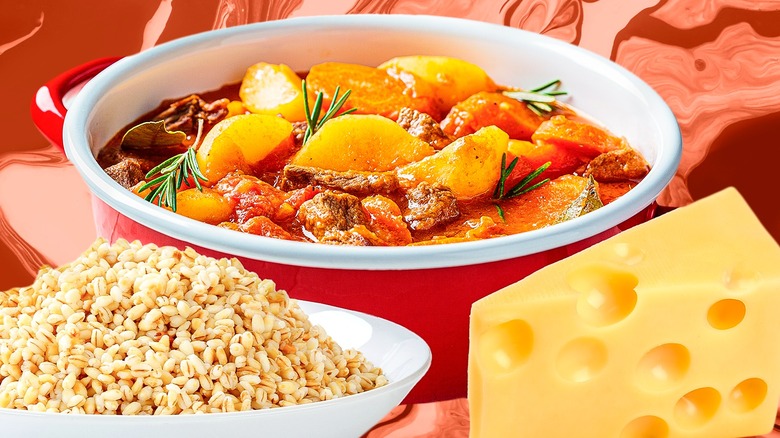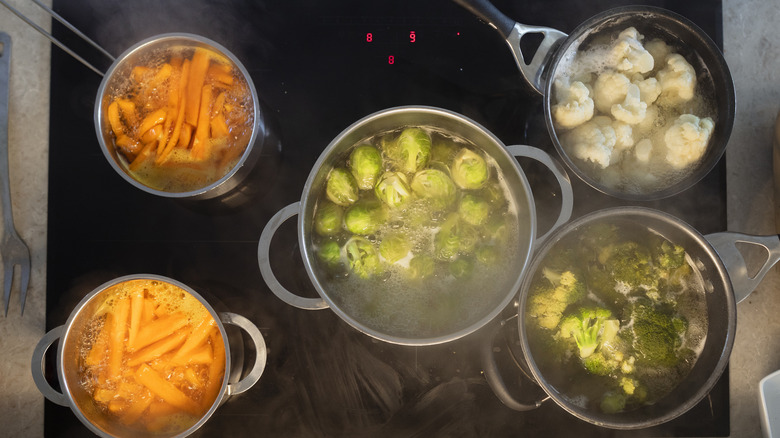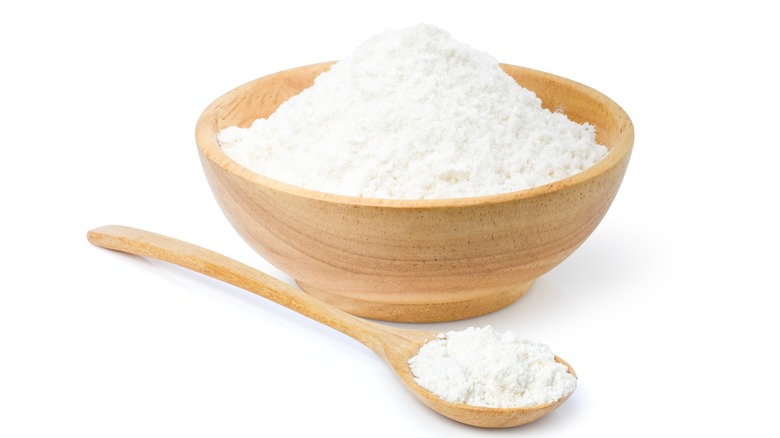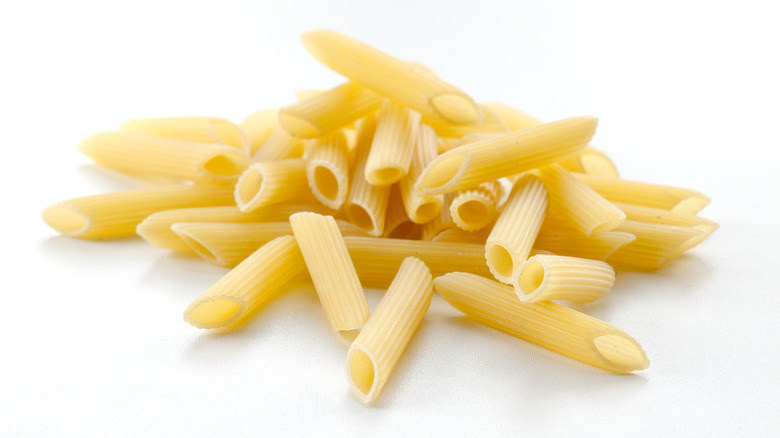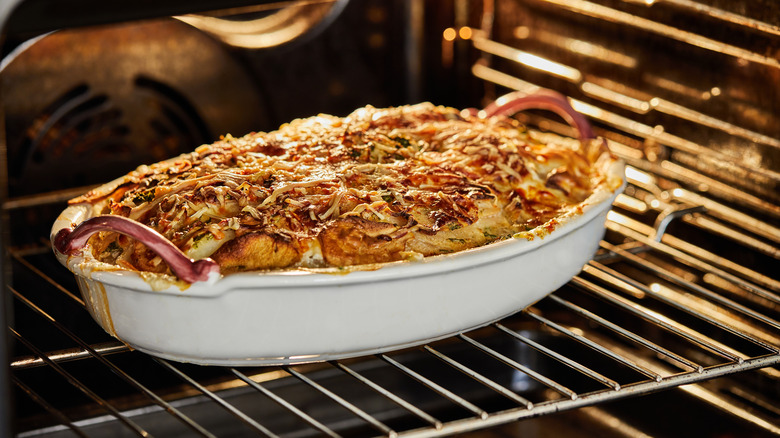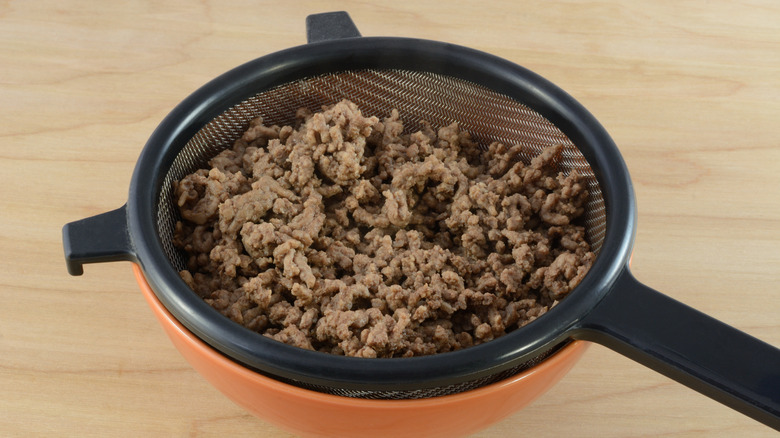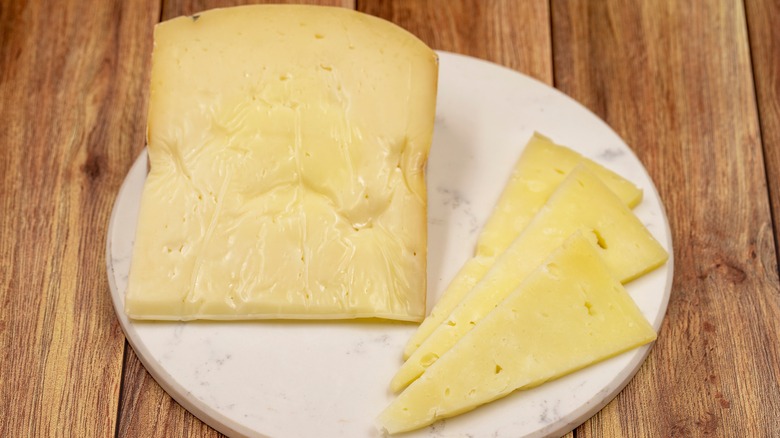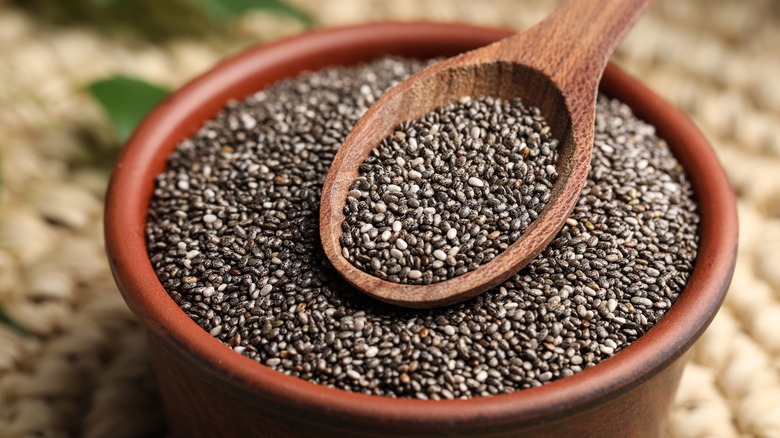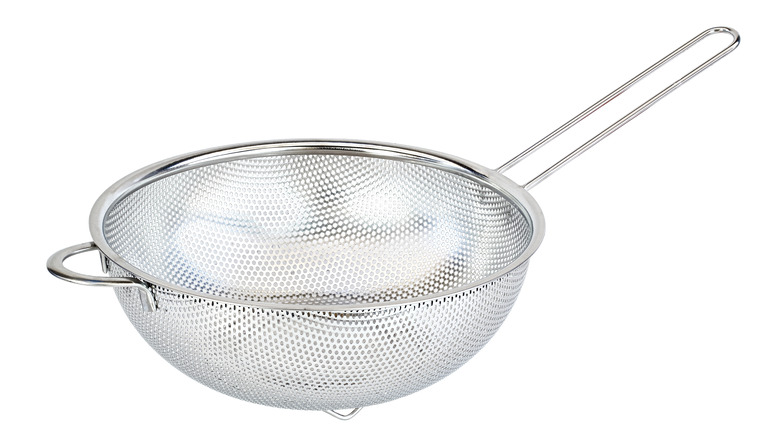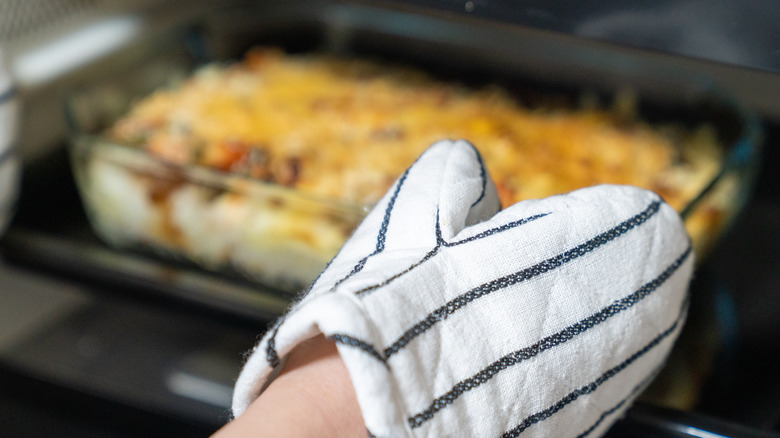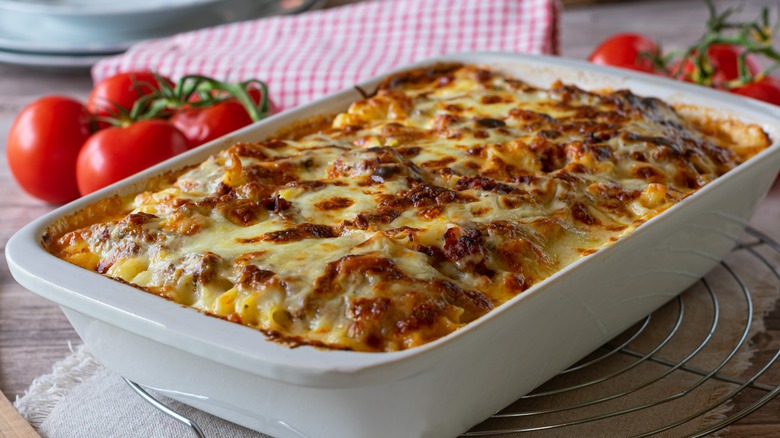10 Tips To Fix Or Prevent Watery Casseroles
On the list of kitchen nightmares, watery casseroles are right near the top. After all, casseroles are supposed to be easy, leave-it-and-let-it-cook dishes you can turn to when you're short on time and energy but still want to make a satisfying dinner. These expectations make the ensuing disappointment all the more devastating. Unfortunately, pitfalls abound when making casseroles. Some of the worst offenders are moisture-rich vegetables, red meats, and high-fat cheeses. There are certainly a lot of dangers to look out for, but not to fear. We've got a collection of ingenious solutions that will rescue your casseroles from the depths of sogginess.
In this article, we'll explore ten tips to fix or prevent watery casseroles, offering you all kinds of hacks sure to transform your casserole game forever. From preparing vegetables to selecting the right starch, you'll be surprised at just how many ways there are to upgrade everyone's favorite cold-weather dish. If you're ready to say goodbye to watery casseroles and embrace perfection, let's dive in.
1. Prep vegetables ahead of time
Whether you're making cabbage au gratin, spaghetti squash lasagna, or a yellow squash casserole, there's a good chance your casserole will contain at least one vegetable. And while vegetables are great for adding some color and nutrition to an otherwise cheese-heavy dish, they often spell trouble. What we mean is that vegetables are one of the biggest culprits when it comes to watery casseroles. That's because vegetables naturally contain a lot of water in their raw form. When cooked, water leaches out, transforming your rich, gooey casserole into a liquidy slop.
That doesn't mean you have to ditch your beloved veggies, though. Instead, you've got to prepare them ahead of time so they won't wreak havoc on your dish. One option is to par-cook watery vegetables such as onions, mushrooms, and squash before tossing them into your baking dish. Cook them just long enough to release excess moisture, drain, and continue assembling your casserole as you normally would. Another option is to sweat vegetables. This works particularly well for vegetables that will be sliced or layered such as eggplant or zucchini. After cutting, sprinkle with salt and leave them in a colander to drain for 30 minutes. Rinse and pat dry before using. When it comes to frozen vegetables, make sure to thaw them in a colander, pat dry, and squeeze out any remaining liquid. Or better yet, avoid them altogether.
2. Add a starch
Even if you're a beginner cook, you probably know that adding a starch can help transform liquidy dishes into creamy delights. Cornstarch and flour are two popular options, but don't you dare add them directly to your casserole. Instead, make a slurry. Slurry may sound like a refreshing summer drink or a gross type of precipitation — depending on who you ask — however, it's a scientific term that refers to a semi-liquid mixture made from water and an insoluble solid.
In this instance, cornstarch and flour are the insoluble solids in question. When mixed with water, they form a viscous solution perfect for thickening all kinds of casseroles and sauces. The ideal slurry ratio is one tablespoon of cornstarch to every two tablespoons of water. Make as much as you need, but try to keep the ratio constant. Once it's ready, stir the slurry into your casserole base before baking. If your casserole still happens to be watery after it comes out of the oven, feel free to mix in more of the slurry before serving. Slurries are essentially tasteless, so there's no need to worry about altering the flavor of your masterpiece.
3. Experiment with pasta or grains
The last two tips help you prevent a casserole from becoming watery before you even start baking, but what do you do if you notice your casserole dish starting to fill up with water while it's in the oven? First things first — don't panic. Just because your casserole is starting to look a bit soupy doesn't mean it's beyond saving. In fact, all you need to do is add some pasta noodles or grains to your base. This trick works for the simple reason that both types of ingredients soak up water as they cook.
When it comes to selecting an add-in, choose something that complements the other ingredients in your dish. For instance, tomato-based casseroles pair well with pasta. We recommend short types of pasta like elbow noodles, penne, and fusilli. However, if all you've got is spaghetti, snap the strains into smaller pieces and stir them in. Pearl barley blends seamlessly with our kale lasagna or Greek Briam bake. With that said, you can scoop out the pasta or barley before serving if you prefer. And if you're looking for a gluten-free option, try smashing instant potato flakes into your casserole base.
4. Take the lid off
If you're throwing together a casserole, there's a good chance it's because you need a satisfying, low-effort meal. While it's true that casseroles are pretty hands-off in general, that doesn't mean you can completely neglect them. More specifically, you've got to pay attention to the amount of time the casserole spends covered versus uncovered.
Covering a casserole (whether with a lid or with aluminum foil) is important because it helps keep moisture and heat inside the baking dish. This encourages even baking throughout, ensuring that noodles come out perfectly al dente and cheese melts uniformly. As important as covered baking is, it's equally important to uncover your dish for at least 10 minutes at the end of the cooking time. This move hits your casserole with an extra blast of heat, something that promotes a crunchy crust and makes excess liquids evaporate. When it comes to choosing the right uncovered-to-covered ratio, following recipe directions is your best bet. If it's not mentioned, split the time, leaving the dish covered for the first half of baking, and then removing the cover for the second half.
5. Drain fat from meat
Vegetables aren't the only ingredient you need to prep before assembling a casserole. Meats like ground beef, ham, or sausage should be cooked ahead of time and drained of their fat. If you've ever fried up strips of bacon or made your own hamburgers at home, then you'll understand why. Red meat, like pork and beef, contains a lot of fat. As the meat cooks, the fat liquifies and leaves a greasy puddle behind. It's one thing if that fatty pool of liquid drains into a pan, it's quite another if it fills up your casserole dish.
With that said, not all meats need to be drained prior to baking the casserole. Lean meats, such as white turkey slices and chicken breasts, should not be drained. Pouring the fat drippings into the casserole with the meat is actually an asset when making recipes like this classic chicken casserole. That's because the fats help prevent the casserole from drying out as it cooks, ensuring a tasty, perfectly moist meal every time.
6. Choose a dry or low-fat cheese
Just as high-fat meats leave behind a pool of grease and liquid when they cook, so do high-fat cheeses. Cheddar, Colby, Fontina, and Swiss are some of the fattiest types of cheese out there, containing roughly 30% fat per serving. Unfortunately, these varieties are also some of the best casserole cheeses in existence. So, what's a cheese-loving chef to do?
Well, one option is to combine fatty cheeses with absorbent ingredients like pasta or potatoes as we do in our recipes for garlic shrimp mac and cheese and cheesy funeral potatoes. Both of these dishes contain cheddar cheese, but the starchy ingredient absorbs some of the cheese grease as they cook. This prevents the casserole from wandering into watery territory. Another option is to use dry or low-fat cheeses in place of fattier varieties. Hard cheeses, such as Emmental and Gruyère, are tasty options that will enhance any casserole without leaving a mess behind.
7. Sprinkle seeds into your bake
This trick sounds unconventional, but it works wonders in preventing watery casseroles, so hear us out. While there are plenty of seeds you should be cooking with, we recommend using chia seeds in your next casserole. Chia seeds are renowned for their ability to take in water. In fact, they're able to absorb 12 times their weight in water. This makes them an ideal choice if you're worried about watery casseroles. What's more, they swell in size when wet and develop a gummy texture, both of which help thicken your casserole base. As if that weren't convincing enough, chia seeds are packed with nutrients like protein, fiber, magnesium, and calcium. To take advantage of these magical seeds, mix one tablespoon of seeds with ⅓ cup of water. Let sit for 15 minutes, then add the solution to the casserole a few minutes before the end of the cooking time.
Although many people mistake cashews for nuts, they're actually seeds. And just like chia seeds, raw cashews are excellent casserole allies to keep around. Cashews are high in fat, something that gives them a texture creamy enough to rival any dairy ingredient. You'll need a ¼ of cashews for every cup of liquid in your casserole. Once you've measured, soak the cashews in water overnight. Drain the water the next morning, then blend. Add the cashew cream to the casserole before sliding the pan into the oven.
8. Remove excess liquid
It can be tough to think rationally when you've got a watery casserole and a hungry household on your hands. In the frantic search for a solution to your dinner woes, you might overlook one of the most obvious ways to fix a watery casserole — pouring out the excess liquid. Yes, it really is that simple (at least some of the time).
To remove the liquid without losing your meal, cover the casserole with a lid, leaving a small gap for drainage. Pour as much liquid out as you can, stirring the casserole occasionally to uncover any hidden puddles. While you can certainly pour the unwanted liquid down the drain, the liquid can also be repurposed. Take advantage of this trick by catching the liquid in a pot, and then simmering it on medium heat until it reduces and thickens. Once thickened, reincorporate it into the casserole. Before you know it, you'll have a thick, flavorful meal ready to satisfy even the hungriest of appetites.
9. Leave the casserole in the oven a bit longer
There are plenty of mistakes you can make with casseroles, but removing a watery casserole from the oven has to be near the top of the list. Compared to a lot of other dishes, casseroles are incredibly forgiving. That means you can feel confident adjusting the cooking time as needed. To put it another way, there's no harm in leaving a slightly watery casserole in the oven for an extra five to 10 minutes. Sure, the crust might brown a bit, but isn't that a small price to pay for the rich, creamy casserole hiding underneath?
This tip works for one simple reason — the heat from the oven causes the liquid to evaporate. While this simple kitchen hack works wonders for slightly watery casseroles, it's not right for every situation. If you've got a Titanic situation happening in your baking dish, no amount of additional time will rescue your liquidy concoction. Should this happen, try draining the excess liquid and adding a starch to thicken the base.
10. Let your casserole sit
Look, we get it. After whipping up a luxurious ham and cheese strata or an indulgent candied yam casserole, the last thing you want to do is wait to dig in. However, we implore you to be patient. We promise, your taste buds and eyes will thank you.
Letting a casserole sit after baking is essential for two main reasons. The first is that you'll avoid burning your tongue and palate on the volcanically hot ingredients. Second, letting a casserole rest gives pasta, meat, and vegetables time to absorb any remaining liquid. This waiting period also helps creamy add-ins such as cheese or soup congeal, making them easier to serve when the time comes. Just 15 to 20 minutes is all it takes for a casserole to come together. Alternatively, if you're making a casserole ahead of time, let it cool completely, refrigerate (or freeze) it, then reheat on command, no additional waiting required.
Static Media owns and operates Tasting Table and Mashed.
